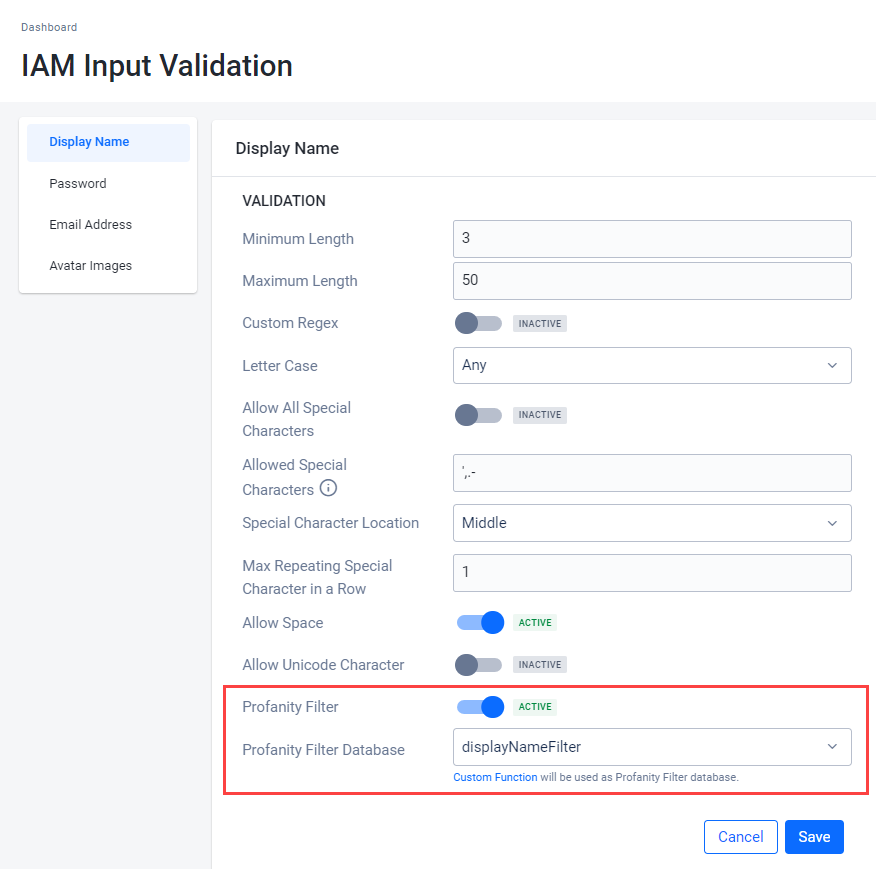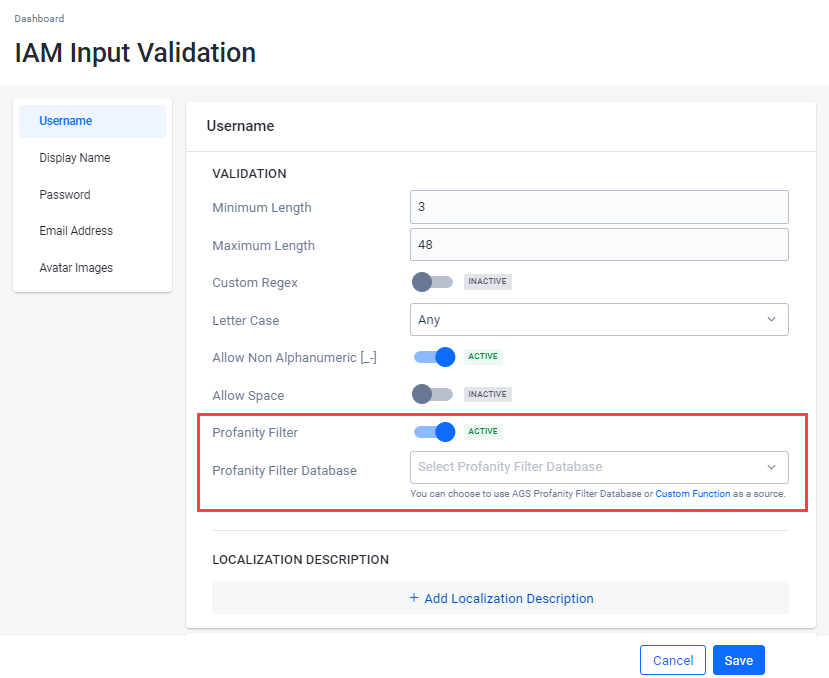Activate profanity filter for validation
Introduction
This article walks you through how to activate the profanity filter in your namespace to validate the display names and usernames of your players.
- The profanity filter feature currently only validates the usernames and display names of your players.
Prerequisites
- You have added profane words to the default profanity filter database. See Register and manage default profane words.
- You have created and configured a designated profanity filter Extend App or set up your own custom server.
- You have created custom profanity filters in the Admin Portal. See Create and manage custom profanity filters.
Activate profanity filter for display name validation
- In the AGS Admin Portal, go to your game namespace.
- On the sidebar menu, click on Game Setup and go to Profanity Filter > Configurations.
- On the Configurations page, go to list of services sections
- It will shows services have supported profanity filter. Currently we only validates the usernames and display names of your players.
- Turn on status toggle.
- After activating the Profanity filter toggle, select the database filter that will be used from the Profanity database dropdown. You can choose the database for the profanity filter
- Default. See Register and manage default profane words.
- Custom filters See Create custom filters.

Activate profanity filter for display name validation
To activate the profanity filter to validate the display names of your players, follow these steps:
-
In the AGS Admin Portal, select Admin Task > IAM Input Validation on the sidebar menu.
-
In the Display Name section, turn on the Profanity filter toggle.
-
After activating the Profanity filter toggle, select the database filter that will be used from the Profanity database dropdown. You can choose the database for the profanity filter
- Default AGS database filter. See Register and manage default profane words.
- Custom filters See Create custom filters.

-
Click Save.
Activate profanity filter for username validation
To activate the profanity filter to validate the usernames of your players, follow these steps:
-
In the AGS Admin Portal, select Admin Task > IAM Input Validation on the sidebar menu.
-
In the Username section, turn on the Profanity filter toggle.
-
After activating the Profanity filter toggle, select the database filter that will be used from the Profanity database dropdown. You can choose the database for the profanity filter
- Default AGS database filter. See Register and manage default profane words.
- Custom filters See Create custom filters.

-
Click Save.
Implement profanity filter with client SDKs
The validate user endpoint is contained inside the User class on both Unity and Unreal SDK.
Validate user input
- Unreal SDK
- Unreal OSS
- Unity SDK
To enable this endpoint, specify the FUserInputValidationRequest model to put it into the parameter function. AGS has several validations including Username, DisplayName, or UniqueDisplayName. If the response is valid, then it will return true. Otherwise, it will return false with an error message.
FUserInputValidationRequest UserInputValidationRequest{};
UserInputValidationRequest.Username = "badwordsexample";
FUserInputValidationResponse UserInputValidationResponse{};
auto ApiClient = AccelByteOnlineSubsystemPtr->GetApiClient(TEXT("YOUR_KEY"));
auto UserApi = ApiClient->GetUserApi().Pin();
UserApi->ValidateUserInput(UserInputValidationRequest, THandler<FUserInputValidationResponse>::CreateLambda([&](const FUserInputValidationResponse& Response)
{
UE_LOG(LogAccelByteUserServiceTest, Log, TEXT("Success"));
}), FErrorHandler::CreateLambda([&](int32 ErrorCode, const FString& ErrorMessage)
{
UE_LOG(LogAccelByteUserServiceTest, Warning, TEXT("Error Code: %d, Reason: %s"), ErrorCode, *ErrorMessage);
}));
To enable this endpoint, specify the FUserInputValidationRequest model to put it into the parameter function. AGS has several validations including Username, DisplayName, or UniqueDisplayName. If the response is valid, then it will return true. Otherwise, it will return false with an error message.
UserInterface = StaticCastSharedPtr<FOnlineUserAccelByte>(OnlineSubsystem->GetUserInterface());
FUserInputValidationRequest UserInputValidationRequest{};
UserInputValidationRequest.Username = "badwordsexample";
FUserInputValidationResponse UserInputValidationResponse{};
auto ValidateUserInputDelegate = UserInterface->AddOnValidateUserInputCompleteDelegate_Handle(FOnValidateUserInputCompleteDelegate::CreateLambda([&](
const FUserInputValidationResponse& Response, bool bWasSuccessful, const FOnlineError & OnlineError)
{
if (bWasSuccessful)
{
UE_LOG(LogAccelByteUserInterfaceProfanityFilterTest, Log, TEXT("Success"));
}
else
{
UE_LOG(LogAccelByteUserInterfaceProfanityFilterTest, Warning, TEXT("Error. Code: %s, Reason: %s"), *OnlineError.ErrorCode, *OnlineError.ErrorMessage.ToString());
}
}));
UserInterface->ValidateUserInput(LocalUserNum, UserInputValidationRequest);
// ValidateInputRequest accepts DisplayName, Username, Password, and UniqueDisplayName. If a field is unused or unneeded, you can leave it as null.
Models.ValidateInputRequest request = new Models.ValidateInputRequest()
{
DisplayName = displayName,
Username = username
};
Result<Models.ValidateInputResponse> validateResult = null;
AccelByteSDK.GetClientRegistry().GetApi()
.GetUser()
.ValidateUserInput(request, result =>
{
if (result.IsError)
{
// Your code to run when there's an error with the API call
}
// Your code to run when the API call is a success
validateResult = result;
});